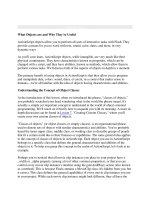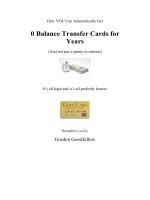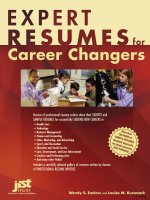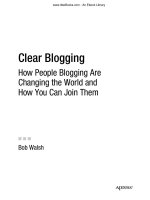switching careers career changers tell how and why they did it learn how you can too
Bạn đang xem bản rút gọn của tài liệu. Xem và tải ngay bản đầy đủ của tài liệu tại đây (1.23 MB, 320 trang )
switching
careers
Robert K.
Otterbourg
Career Changers
Tell How–and Why–
They Did It.
Learn How
You Can, Too.
switching
careers
OTHER KIPLINGER BOOKS
Kiplinger’s Practical Guide to Your Money
Kiplinger’s Practical Guide to Investing
But Which Mutual Funds?
Making Money in Real Estate
Buying & Selling a Home
Financing College
Retire Worry-Free
Retire & Thrive
Dollars & Sense for Kids
Next Step: The Real World
Home
•
ology
Taming the Paper Tiger at Home
Know Your Legal Rights
The Consumer’s Guide to Experts
KIPLINGER’S BUSINESS MANAGEMENT LIBRARY
Business 2010
Customer Once, Client Forever
Raising Capital
Taming the Paper Tiger at Work
Cash Rules
Hunting Heads
Parting Company
You Can’t Fire Me, I’m Your Father
Kiplinger offers excerpts and tables of contents for
all of our books on our Web site (www.kiplinger.com)
For information about volume discounts contact:
Cindy Greene
Kiplinger Books & Tapes
1729 H Street, N.W.
Washington, DC 20006
e-mail:
202-887-6431
KIPLINGER BOOKS
Washington, DC
switching
careers
Robert K.
Otterbourg
Career Changers
Tell How–and Why–
They Did It.
Learn How
You Can, Too.
Published by
The Kiplinger Washington Editors, Inc.
1729 H Street, N.W.
Washington, D.C. 20006
Library of Congress Cataloging-in-Publication Data
Otterbourg, Robert K.
Switching careers : career changers tell how and why they did it : learn how you can too
/ Robert K. Otterbourg.
p. cm.
Includes index.
ISBN 0-938721-86-0 (pbk.)
1. Career changes United States Case studies. I. Title.
HF5384 .O874 2001
650.14 dc21 2001038034
© 2001 by The Kiplinger Washington Editors, Inc. All rights reserved. No part of this book may
be reproduced or transmitted in any form or by any means, electronic or mechanical, including
photocopying, recording or by an information storage and retrieval system, without the written
permission of the Publisher, except where permitted by law.
This publication is intended to provide guidance in regard to the subject matter covered. It is
sold with the understanding that the author and publisher are not herein engaged in rendering
legal, accounting, tax or other professional services. If such services are required, professional
assistance should be sought.
First Edition. Printed in the United States of America.
9 8 7 6 5 4 3 2 1
Kiplinger publishes books and videos on a wide variety of personal-finance and
business-management subjects. Check our Web site (www.kiplinger.com) for a
complete list of titles, additional information and excerpts. Or write:
Cindy Greene
Kiplinger Books & Tapes
1729 H Street, N.W.
Washington, DC 20006
e-mail:
To order, call 800-280-7165; for information about volume discounts, call 202-887-6431.
To Susan, Laura, Katherine, Kenneth and Sam. Each helped
me in their own way to focus on many of life’s challenges.
Dedication
areer changing has hit home. Kathy, my daughter-in-
law, after 15 years as a self-employed interior design-
er, has returned to college, the first step toward certi-
fication as a high school history teacher.
Switching
Careers
was written for folks like Kathy who are planning to
change careers.
Interviewing the folks profiled in this book was a delightful
experience. What challenging stories they have to tell. I want to
thank them for their candor in discussing their careers, past
and present.
As you’ll soon discover, no two career changers took the same
route. You’re in for a treat as they describe how they made their
workplace and lifestyle journeys.
A few people were particularly helpful. As a Colgate
University alumnus, I turn regularly to Jim Leach, assistant to
the president of the university. Jim’s a great guy who has an
uncanny way of ferreting out the names of interesting folks to
interview. Greg Duncan works here in Durham as director of
admissions and student life at Duke Divinity School. I appreci-
ate his forthrightness in describing the intricacies of a world I
know little about—a divinity school education and the chal-
lenges facing ministers.
I am also grateful to the Durham County Public Library for
stocking the books and magazines not available on the Internet.
As I’ve noted in previous books, a library is a great place to do
research when you’re tired of staring at a computer screen.
Once again, I’d like to thank my literary agent, Edward
Knappman of New England Publishing Associates. Among his
Acknowledgements
C
many fortes, he moves a book project along and handles the
numerous business and contractual arrangements.
This is my third book that Kiplinger Books has published in
a relationship that dates back to 1993. It’s time to give “gold
stars” to David Harrison, publisher, and Patricia Mertz Esswein,
managing editor. David has a flair in knowing how to work with
authors in bringing books like
Switching Careers to market. His
involvement does not stop. David actively supports authors in
the years after the first edition, first printing, hits the market.
Once again, it has been a joy to work with Pat. She brings tact,
skill and a personal touch to editing a manuscript, and she asks
the questions, often humorously, that need to be asked so that
the resulting book is both accurate and easy to read.
Thanks, also, to Priscilla Taylor, who smoothed the manu-
script; to Allison Leopold, who proofed the pages; and to
Heather Waugh, who created such an attractive cover and inte-
rior design for the book.
Lastly, thanks Susan. Did you know when we met more than
40 years ago that you would be listening to me years later drone
on about the people I’ve interviewed and the things that
I’ve learned?
ROBERT K. OTTERBOURG
Durham, North Carolina
Introduction xiii
Preface xv
CHAPTER 1: Leaving Behind ‘A Foolish Consistency’ 1
Reasons for Career Switching • Fewer Financial
Consequences • Debunking a Few Myths • What
About Downsizing? • Where Are the Jobs? • Multiple
Career Changers • What’s Ahead
CHAPTER 2: Planning Your Mission and Strategy 15
What’s Your Mission? • Take Some Tests • Try It On for
Size • Back to School? • Financial Planning • How the
Military Helps Career Changers • A Handy Planning
Checklist • Some People Who Made the Change:
Career Counselor Was Once a Potter
Name the Career and He’s Done It
Tr ial Lawyer Becomes an Executive Search Consultant
Former Corporate Marketer Handcrafts Jewelry
Former Maryknoll Priest Finds a New Identity as a Carpenter
Classical and Jazz Bass Player Likes Litigation
CHAPTER 3: Recycling Existing Skills 41
Career Changers Are Packaging Experts • An Opportunity
to Be Creative • Are You Simultalented? • Some People
Who Made the Change:
From Cop to Lawyer to Doctor
Librarian Goes to Law School Blends News and Web Site
Skills Into a Single Career
Ta b le of Contents
Retailer Uses His Know-How to Counsel Entrepreneurs
Small Press Publisher Is Small Town Lawyer
CHAPTER 4: Improving the Quality of Your LIfe 59
Working at Home or Anywhere • Seeking Simplification •
Do Clothes Really Make the Man? • Full-Time, Part-Time,
or Temporary • Where Should I Live? • Converting a
Hobby Into a Full-Time Job• Some People Who Made
the Change:
Shifted Her Social-Work Skills Into Advertising Sales
Analog and Digital Musical Recordings Are His Gig
Trades in Commuting for a Local Job Magazine
Writer Takes a Break and Returns to Work
Lifestyle Critical as a Clinical Social Worker
Buying a Country Inn Is an Antidote to a City Lifestyle
CHAPTER 5: Meeting the Future Now:
Information Technology 85
More on the Job Market • The Web Workplace • Who
Does What and How Do You Obtain the Necessary
Skills? • Some People Who Made the Change:
Nontechies in a Techie World
A Series of Careers Lead to the Computer Classroom
A Trucking Accident Leads to a Career as a Computer Analyst
Took the Leap to Freelance Web Site Designer
A Professional Photographer Becomes an E-Commerce
Web Programmer
From Speech Pathologist to Computer Educator
Nonprofit Consultant Goes Online
CHAPTER 6: Blending Many Skills in the Clergy 109
The Job Market • The Calling • Preparing for Divinity
School • Divinity School • The Pay • Some People
Who Made the Change:
From Naval Officer to Lawyer to Ordained Priest
“There’s No Business Like Show Business”
From Librarian to Community Activist to Rabbi
There’s a Higher Calling Than Commercial Banking
Divinity School Publicist Goes to Divinity School
T ABLE OF CONTENTS
T ABLE OF CONTENTS
CHAPTER 7: It’s Never Too Late to Be a Lawyer 133
The Job Market • Entry-Level Salaries • Getting Into
Law School • Related Careers • Some People Who
Made the Change:
Actor Has a New Role as a Lawyer Naval Aviator
Switches to Corporate Law Neonatal-Nursing
Specialist Does Malpractice Law
A Bank Vice President Goes to Law School
A Newspaper Editor Switches to Corporate Law
CHAPTER 8: Entering Medicine:
Not for the Faint of Heart 157
Medicine • The Job Market • Getting Into Medical School •
The Importance of MCATs • The Cost • Nursing • Getting
Into Nursing • Some People Who Have Made the Change:
A Long Road to Become a Physician
A Physician Via Management and Law
An Abstract Painter Is Now a Physician
From Hygienist to Dentist
From a Series of Odd Jobs Into Nursing
A Pharmacologist, Entrepreneur and Stockbroker
Becomes a Nurse
CHAPTER 9: Teaching:The Classroom Is Calling 189
The First Steps Toward the Classroom • Earnings in the
Classroom • A Shortcut to Teaching • Three Alternative
Certificate Programs • Independent Schools:Another Route
Into the Classroom • Some People Who Made the Change:
From Nuclear-Submarine Officer to High School
Physics Teacher
From the Army to the Classroom to the School Office
Education via a Travel Business and the Peace Corps
Many Sacrifices to Become a Teacher
A Corporate CEO Finds His Answer in Teaching
A Radio News Director in the Classroom
CHAPTER 10: Becoming Your Own Boss 215
The Numbers Speak for Themselves • Why They Take
the Plunge • Let’s Get Started • A Word of Caution •
Time to Do Some Homework • The Do-It-Yourself
Approach • What About Franchising? • Taking Over a
Family Business • Some People Who Made the Change:
Out of Chemical Sales Into a Graphics Design Firm
They Leave IBM for Self-Employment
Desert Storm Was His Route to Becoming an Entrepreneur
From Teaching in Kenya to Heading a Family Business
A Nurse and a Cop Own a Jewelry Store
Boyhood Hunting Gives Birth to a Business
CPA Turns Hobby Into a $70 Million Niche Operation
CHAPTER 11: Pursuing Your Art and Your Craft 247
Another Perspective on Artisans • How About a Career
as a Chef? • What About a Career in Journalism or
Communications? • Some People Who Made the Change:
From the Army to Journalism
An Art Director Designs Architectural Woodwork
Madison Avenue Copywriter Writes Children’s Books
A Neuropsychologist Makes Pottery
A Dress Designer Turns to Old-Time Films
Cooking Beats Commercial Banking
An Interpreter for the Deaf, Baker, and Restaurant Manager
From Geologist to Realtor to Wildlife Artist
CHAPTER 12: Using Your Skills in Nonprofits 277
A Demanding Career Path • An Impressive Job Market
With a Lower Pay Scale • An Easy Transition From the
For-Profit Sector • Learn the Basics • Nonprofit Management
Courses • Some People Who Made the Change:
Building for Profit and Building for Passion
Being a Lawyer Was Never Enough
Hockey Professional, Pianist and Fund-Raiser
From the Newsroom to a Niche Nonprofit Agency
Banking Gave Him a Leg Up in Nonprofits
Index 299
T ABLE OF CONTENTS
Switching Careers xiii
hen I was a kid back in the 1950s and early
’60s, careers were forever.
The family breadwinners I knew (almost all
of them fathers, with hardly an employed mom
among them) all had a career, and it was the same occupation
they started as young adults, right out of college or military
service. And the odds were great that they would pursue this
career for the rest of their lives.
There were exceptions, of course. There were fathers
about whom it was whispered that “he can’t hold a job,” or
“he’s a restless sort,” or “he doesn’t know when he’s well off.”
These men would change employers, or even occupations,
every few years. Rather than admire their ambition, or at least
respect their courage, we assumed something was wrong with
them, and we felt sorry for their families—even if mom and
the kids seemed otherwise “normal” and perfectly happy.
It was an era of relative economic stability. Workplace loy-
alty was strong, and it was a two-way street. Workers didn’t
change jobs very often, because people with a good, decent
job considered themselves lucky. And employers rarely laid
off employees who were doing satisfactory work, just because
of a slump in the business. Sure, temporary layoffs and call-
backs were always part of the blue-collar world of manufac-
turing, but “downsizing” and “restructuring” hadn’t yet crept
into the consciousness of white-collar managers.
But today, all of this is a long-ago memory. In the ’60s and
’70s Americans discovered “self-fulfillment” and “following
your dream.” After wrenching recessions in the late ’70s and
W
Introduction
early ’80s, the U.S. embarked on a nearly two-decade eco-
nomic expansion that tightened labor markets and improved
the employment prospects of restless career-changers. Back
when workers were plentiful, an employer could easily pass
over an applicant whose checkered résumé branded her as a
“job jumper.” But in a labor-tight world, job changes and
career switches are no longer an automatic taint.
These days, career switching is as American as . . . fast food.
I have to admit that I have no personal experience with it. I’ve
spent my entire working life in one occupation, journalism,
although I did work for three different news organizations in
the 13 years before I came to Kiplinger in 1983.
But I count among my acquaintances many successful
career changers, including a teacher who became a dealer in
rare musical instruments, a nurse who is now a news photog-
rapher, a corporate lawyer who became a minister, and a
businessman who now teaches high school calculus.
In his wonderful new book,
Switching Careers, Bob
Otterbourg will introduce you to many fascinating men and
women who have pulled off successful career changes of their
own. And he will give you lots of practical advice on how you
can do the same—after plenty of planning, counseling and
financial preparation.
Some folks profiled in this book made major financial sac-
rifices to pursue their dreams, while others dramatically
boosted their earnings by following their gut instinct and
changing careers. Either way, they all are happy they gave it
a try. Perhaps you will be, too.
My best wishes to you as you contemplate—and perhaps
embark on—a life-changing decision to hitch your wagon to
a very different star.
KNIGHT A. KIPLINGER
Editor in Chief, The Kiplinger Letter and
Kiplinger’s Personal Finance magazine
INTRODUCTION
xiv Switching Careers
E
ars prick up whenever I mention the subject of this
book, career-changing, at a social gathering, and
although I’m not a career counselor, my listeners pep-
per me with questions: Am I too old to change? How do
you know that the new career is the right one? I wonder what
my spouse, business associates and family members will say
when I tell them?
I shouldn’t be surprised that there is so much interest in
career changing. Career changing is closely tied to workplace
and lifestyle expectations. We expect to find meaning, challenge
and satisfaction in our work lives, to be able to balance our work
with our personal lives, and to earn enough income to support
our varied goals. Career changing has few foes. Even career loy-
alists want to know if there is a more satisfying way to practice
their trade.
At the heart of this book are profiles chronicling the experi-
ences of nearly 70 career changers. For many people, deciding
to switch careers begins with or proceeds from a series of casual
conversations, like those I just described. They’re sniffing out
the possibilities. Reading this book is like attending a cocktail
party with 70 career switchers who have accepted the invitation
to share their stories with you.
All of the people I interviewed have changed careers within
the past few years, although some are still in professional or
graduate school on their way to their new careers. The profiles
illustrate that a career change need not be some radical lifetime
event. Through planning, making the change can appear to be
a seamless transition. Other changeovers, like going to medical
Preface
Switching Careers xv
school at age 36, are more dramatic.
The profiles contain much more than an array of biograph-
ical information. From the profiles, readers can learn by
“observing” how to plan a career change, how to pay for it and
live while making it, how to anticipate the effects that career
change will have on one’s mate and children, how long it may
take to get established in a new field, how
old skills carry over to new careers, and,
finally, how to fulfill the desire for greater
control over one’s life.
The profiles teach by example, but they
also inspire and reassure. No two career
changers have ever done it exactly the same
way. They weigh their desires, skills and
experiences, obligations and commitments,
relationships, tolerance for risk and debt,
and they devise their own recipe for success
in a new career. The decision to change
careers is sometimes all head, and absolutely
rational; at other times it is all heart, and sometimes even divine-
ly moved. The determination for some people was literally made
overnight, while others mulled over it for several years.
I wrote
Switching Careers for men and women who are old
enough to have some career experience but young enough to
have ample time to enjoy the fruits of their career changing for
another 15 to 20 years—people ranging in age from just under
age 30 to the early 50s. To some people the simple solution to
career dissatisfaction is to retire in one’s 50s and avoid the chal-
lenge of a career change. Others acknowledge this challenge in
their 30s and 40s and switch careers. By age 65 they will have
spent, say, the first 20 years of their work lives as a banker and
an equal number of years teaching school.
Career changers under age 30 have the luxury of switching
careers on a whim. Tired of teaching or writing advertising
copy? Why stick it out? Nothing is really lost by going in a dif-
ferent direction, even if it means returning to college for anoth-
er degree. Obligations are relatively few. But the older the
career changer, the more deliberate the decision must be.
Families, mortgages, and other obligations often temper risk.
PREFACE
xvi Switching Careers
The older the
career changer,
the more deliberate
the decision
must be. Families,
mortgages, and
other obligations
often temper risk.
PREFACE
That’s why all the people I’ve profiled here are in their mid
30s to early 50s, except for Jerome Watson-Peters (profiled in
chapter 2) who, now 60, relates his transition from overseas mis-
sionary priest to a life outside the church as a carpenter.
The people who are profiled had to pass an unofficial litmus
test. I avoided celebrities and people who had made a killing in
the stock market. What interested me were men and women
who had had to make some personal or financial sacrifice to
switch careers. The profiles sketch what their challenges were,
and how they confronted them.
As this book points out, there is no simple way to describe
career changing. The lawyer who leaves a law firm partnership
to join a corporate legal staff or the teacher who switches from
public- to private-school education are both career changers.
They tweaked their careers with a simple U-turn. Other career
changers are bolder, making a 180-degree career turnaround,
often requiring years of additional education or entry into a
risky venture. Whatever the strategy, most career changers
adhere to one basic tenet: “Everything I’ve ever been, I still am.”
Given their careers and interests, nearly all of the career
changers presented in this book could easily have been profiled
in two or more chapters.
Besides the profiles, each chapter in
Switching Careers has two
other key elements: (1) information on demographic trends in
the market for the profession or set of skills being discussed and
(2) tips for getting started in a particular line of employment,
plus references to organizations, Web sites, and schools that
might be helpful.
Although no index exists to describe the level of career
changing today versus that of a decade ago, I sense that the
tempo has picked up in recent years. Why? Thanks to diverse
trends from downsizing to telecommuting, we are no longer a
nation of “company men,” dedicated to a single company or
career for life. Our computer- and communications-driven soci-
ety has opened up new lifestyle and workplace vistas hardly
dreamed of a generation ago. The office, once a cubicle or suite
in a corporate setting, is now as near as the spare bedroom down
the hall. Even in the most formal offices, workers have shed for-
mal or traditionally “corporate” attire in favor of an informal
Switching Careers xvii
attire. Sportcoats once unheard of in a large law firm or com-
mercial bank are considered acceptable attire. There’s a sense of
freedom and possibility in the air, fueled, too, by the so-called
talent shortage. The advantage has been to the job seeker.
What’s more, we are impatient. We ask ourselves, Do we want to
be lawyers, bankers, teachers, computer programmers, or chefs
for the next 20 or 30 years? The answer “no” motivates many of
us to switch careers.
Wherever possible, I’ve provided statistics to illustrate the
possibilities and limitations of shifting careers. In some
instances, I relied on data supplied by recognized industry or
professional organizations. I also referenced two excellent U.S.
government resources: the Department of Education’s National
Center for Education Statistics (www.nces.ed.gov) and the Labor
Department’s Bureau of Labor Statistics (www.bls.gov). Both
agencies use real numbers that have been thoroughly
researched.
Above all, my intention was to strike a balance so that how-to
advice and statistics did not become overwhelming. The profiles
provide the balance—showing real-life examples of men and
women who switched careers in their late 20s to early 50s.
Finding the Career Changers
I
feel at home writing about career changing. I switched
careers in my mid 50s, when after decades in public rela-
tions, I decided once again to use my writing skills to write on
subjects that interested me, the reason I had originally gone to
journalism school.
Finding people to interview was never a problem. No need
for me to prepare an Internet solicitation: “A writer needs
names of people who have changed careers.” I discussed my
book with some close friends, who produced names, often their
relatives. Through long-time New York friends, Dorothy and
Larry Arnsten, I met Will Russell, their son-in-law (profiled in
chapter 4), a computer technician who now owns an electronic
recording studio. Deborah and Stanley Slom’s son-in-law, Greg
Vimont (profiled in chapter 5), a former commercial photogra-
PREFACE
xviii Switching Careers
PREFACE
pher, is a database modeler. From my college friend, Jack
Travis, and his wife, Mary, I met Peter, their son (profiled in
chapter 2), a litigation lawyer and law-firm partner, now an
executive-search consultant. My wife and I play tennis with
Tom and Marilyn Sawyer, whose son, Steven (profiled in chap-
ter 7), a one time Navy helicopter pilot, practices corporate law.
In fact, Peter Travis was exiting law about
the same time that Steven Sawyer was grad-
uating from law school.
For other names, I didn’t have to go much
further for assistance than members of my
family. My wife, Susan, suggested some stu-
dents in one of her Duke continuing-educa-
tion courses; daughter Laura came up with
career changers in law, medicine, Web man-
agement, and computer programming; and
son Ken and daughter-in-law Kathy led me
to their current next-door neighbor, who
went from sales engineer to owner of a
graphics-design firm, and a former neighbor, a dress designer
turned film curator.
When I interviewed Lucia Greene Connolly, she suggested
that I call her career-changing sister, Stephanie Greene. Greene
then recommended her husband, George Radwan, another
career changer. Thus one family produced three profiles.
There’s strong military representation in the profiles. Scott
Maitland, Glenn Ruffenach, and John Shemwell are service-
academy graduates (West Point or Annapolis). They left the ser-
vice in their late 20s or early 30s to pursue careers in business,
journalism and teaching respectively. Ramona Ramirez and
Cora Straight were in the Army for 20 years. They took early
retirement when in their early 40s and now teach school.
The part of North Carolina where I live, which has with
three large universities and a number of smaller ones, proved to
be a rich resource. It is also home to a flourishing community of
artisans and craft potters. But almost half the people profiled
are from 16 states, and the experiences of everyone that I’ve
profiled, regardless of where they live, are illustrative of the
challenges and rewards of career changing.
Switching Careers xix
The experiences of
everyone that I’ve
profiled, regardless
of where they live,
are illustrative of
the challenges and
rewards of career
changing.
Because Switching Careers is meant to help readers prepare
for a career change, I have included Web sites for most of the
organizations that were cited. Ten years ago, I would have used
an organization’s mailing address, telephone number, and a toll-
free number. For this book, I assumed that most wannabe career
changers will use the Internet to do their basic research.
I believe that career changing is a natural occurrence in an
age when we seek workplace challenges, a better lifestyle, and an
ability to explore different occupational opportunities, while fac-
ing the possibility of being downsized from our present job. So,
as the Boy Scout’s motto says, “Be prepared.”
PREFACE
xx Switching Careers
switching
careers
CHAPTER 1
W
HEN MANY OF US WERE CHILDREN, OUR PARENTS
asked us, “What do you want to do when you
grow up?” This was a serious question demand-
ing an equally serious answer. It was assumed that
the choice was binding, often for the next 40 years.
This attitude no longer prevails because the lifetime com-
pany employee is a vanishing breed. The stigma against career
changing is declining, many workplace and lifestyle options
considered radical a generation ago are becoming acceptable,
and the financial risks are decreasing.
All types of estimates bounce around on the rate of career
changing taking place in the U.S. At best, these figures are stabs
in the dark. What is known, thanks to the outplacement firm of
Drake Beam Moran, Inc.’s recordkeeping, is that job turnover
is high—the average 32-year-old has held nine full- or part-
time jobs since entering the workforce, and only one in three
workers has held the same job for five years.
A willingness to switch careers harmonizes with what is
occurring in other parts of our lives. We are peripatetic. We jet
here and jet there. We begin college at one school and graduate
from another. We dispose of products rather than repair them.
We lease cars to avoid a long-term commitment, and, tragically,
we sometimes even marry with the same attitude.
Leaving Behind
‘A Foolish
Consistency’
Switching Careers 1
Even within the Roman Catholic church, an institution
known for constancy and tradition, there are career changers.
WEORC (an Old English word for work) is an association of
former priests and nuns who moved from the full-time
ministry to other work; its goal is to help these people make
the transition to a civilian workplace. Its members include
numerous social workers, teachers and even some lawyers and
computer experts.
Writing in late 1999 in the
New York Times Magazine before
any signs of any economic slump, Michael Lewis said that
ditching a job is today’s secret for success—yet it runs contrary
to the theme of persistence we were taught early in life,
depicted in books like
The Little Engine That Could. “Persever-
ance, like honesty, is one of those values that wind up being
over-rated because no one likes to be seen making the case
against them. But that case—the case for being a quitter—is, in
the current economic boom, looking stronger every day. The
taste for quitting is both cause and effect of the current boom,
which is about people starting new things.” Lewis’s favorite
quitters are Michael Dell and Bill Gates, both of whom left
college before graduation to start, respectively, Dell Computer
and Microsoft.
Bob McDonald and Don Hutcheson, career consultants and
founders of the Highlands Program, a think-tank operation
(www.highlandsprogram.com), consider 30 to be a pivotal age
when an “I want it all—now” attitude starts to prevail. Donald
and Hutcheson observe that turning points in adult working
lives occur every seven to ten years, and with each turning point
comes crisis—the feeling that everything in our lives is falling
apart. During this period, people ask themselves some key
questions: If my career keeps going in the same way it is moving
now, where will I be in ten years? Why? What do I want to add
to my life to make it fuller? What else should I be doing?
Reasons for Career Switching
T
he reasons for wanting to switch careers range from the
practical to the idealistic. Most likely your list will include
many of these factors:
LEAVING BEHIND ‘A FOOLISH CONSISTENCY’
2 Switching Careers
CHAPTER 1
• You have a chance to escape a fast-lane urban lifestyle.
• Your job and career no longer interest you; maybe they
bore you.
• The idea of 20 more years in the same career has lost
its appeal.
• You would like to work in a different part of the country.
• You’ve been downsized, fired, canned, pinked-slipped, or
whatever you—and your former employer—want to call it.
• You see little room for future growth in your current career.
• You feel a “calling” to do something else in life.
• You want to be your own boss.
• You want to convert a hobby into a full-time occupation.
• A “glass ceiling” has frustrated your corporate-career plans.
• You want to tap into the more dynamic growth that is expect-
ed in other careers.
• You don’t want to work so hard.
• You want to blend two or more careers into a single career, as
Shawna Lemon (profiled in chapter 3) has done. Now work-
ing as a patent attorney with science-based clients, she has
found a career that blends her doctorate in pharmacology
with her law degree.
• You realize that you jumped into a first career without really
thinking or were pushed into it by your parents.
• You have inherited or are about to inherit a tidy sum. Some
economists predict that trillions of dollars will change hands
from parent to child over the next 20 years. Along with this
windfall will come the possibility of greater economic free-
dom and an ability to change careers without suffering a seri-
ous financial setback.
• You want to “make a difference.” Regardless of the position
or title they hold, many people feel that they are only cogs
within their organizations, and they want to do work that
they view as important—for their own sake and, often, for
the sake of others.
Once you’ve made the decision, the next step is to do
something proactive, said Lisa Schwartz, a career coach in Cary,
N.C. The options are clear: Stay in the same job in the same
organization, change jobs and companies, or switch careers.
Switching Careers 3









